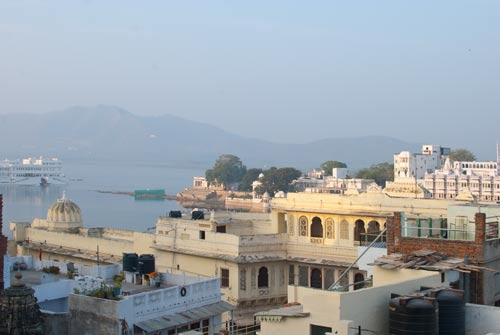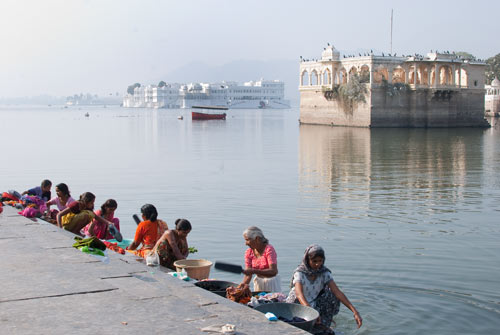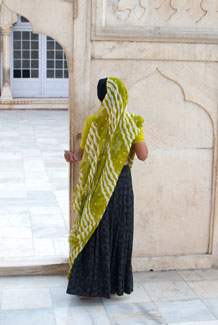
Havelis
I’m writing this entry while sitting in our room in a ‘haveli’, a traditional heritage house of the kind found in the Indian states of Rajasthan and Gujarat that have been turned into guesthouses in modern times.
This haveli where we are staying was once the home of one family, we have been told. Our spacious room that’s decorated with a bright, painted, floral frieze is up six flights of narrow stone steps. All of the guest rooms are set around a stone-pillared courtyard and the haveli in general is bright and airy.
There’s no hot water for the sink, which frankly bothers me since I depend on hot water to wash. Still, that’s a reality around much of India, and in general this room is the nicest we have experienced yet in India.
The Romantic City of Udaipur
We are currently in the city of Udaipur. A city with a population of about 390,000, it is known for its palaces and the lake around which it is set.
From the rooftop restaurant in the haveli where we are staying, the city looked cozy and charming last night. Fairy lights dotted the buildings, hanging from balconies to glimmer in the evening lights. And as it’s the marriage season here in India – we had the treat of seeing a lovely fireworks display in the night’s clear skies. Fireworks are a wonderful custom here that many couples want to mark their wedding day.
Isn’t It Romantic
Palaces, fairy tales, sparkling lights, weddings celebrated with beautiful fireworks these are elements of what many of us consider to be romantic.
Now as I am writing this today on Valentine’s Day, I figure I will explore where the word ‘romantic’ comes from.
The Origins Of The Word ‘Romance’
It turns out that it comes from the Old French expression ‘romant’ which ultimately stems from a Latin word that means ‘in the Roman manner’.
Through this link with the Romans, the concept of ‘romance’ refers, of course, to the emotions of love as conceived in Western society, with the idealization of another person and of a relationship with that object of desire.
To be romantic has also evolved to mean when one is not sensible about practical matters, when one is an idealist, soulful and unrealistic about ‘the real world’.
Cross Cultural Aspects: When Romance Takes On Other Forms
Around the world, most people hunger for romance of some sort in their lives in the myriad of forms that it can take. Visitors like myself from other countries to India where I am now also bring with them their unique views of what is romantic even as they experience different cultural evidences of this aspect.
For example, for me the sari that women wear here in India is one of the most romantic aspects of the country. The vast majority of women wear them, and my eyeball survey says that they dominate the mode of dress with Western clothing far less frequently worn.
Visiting A Local Bazaar
Right before our 13-hour journey by train from Agra (home of the Taj Mahal and other wonderful monuments) here to Udaipur, we decided to go to the local bazaar.
People here in India use the term ‘bazaar’ for a collection of stores running on either side of a broad avenue and the one we visited was very run down, dusty, and decrepit when judged by Western standards.
I had read that bazaars in Agra often had nice saris, so I asked the owner of a local bookshop if there was such a store in the bazaar.
He directed me to another nondescript store a bit further down on the strip. I was delighted to see when we went inside the shop that the standards inside were a lot higher than one expected from the storefront.

Sari Spotting
No sooner had I stepped inside its fairly large premises, however, than I noticed a huge collection of saris folded in cubbyholes that extended from the floor to the ceiling and across the length of the store.
The fabrics looked dazzling from the array of colors. Appliques made from glittering gold and silver shone off the lights. I thought back to our visit to the Taj Mahal a few days earlier and all of the saris that I saw worn by women there, to the hues of the multitude of saris throwing a rainbow of color out into the white-marbled stateliness of the Taj.
The sheer romance of it all was etched in my memory, and so it came streaming back into my consciousness as I looked at the store’s wide selection.
Rippling Silks
A young Indian salesman must have recognized the look in my eyes, and so he launched into his sales pitch about the clothing.
Although saris can be made of cheap material, I imagine that upon seeing that I was a bit of a starry-eyed foreigner as I oohed and aahed when I looked at the saris on the shop’s mannequins, he and his assistants started zipping open a number of plastic storage cases to show me some of their expensive saris.
Made of the finest silk, the saris had brocade, organza, and other elements in their making. I told him that I especially liked earth tones of greens and cinnamons, steel grays and blues, rich purples, and black. Out came rippling examples, with fine details of birds, flowers, and the like.
David and I kept on marveling at the fabric and colors, and most of all at the beautiful handiwork on display.
The Physical Dimensions Of An Average Sari
Our salesman told us that every sari is about six-and-a-half metres long (21 feet) and about one metre in width (39 inches).
I was surprised that there are not different lengths because women are different heights and sizes, but he told me that this was the norm that is used.
It’s astonishing to see just how long this is, and as I was looking wide-eyed at what was before me, the salesman enticed me further and invited me to try on one of the saris. Surely he could tell I was quite smitten by their beauty, and naturally he was hoping for a sale.
The Convincing Salesman
As I sat observing him and his salesmen show their saris, I was conscious of how Western I looked and how far my clothing was from the flowing beauty of the saris.
My t-shirt, worn jeans, and walking shoes were the comfortable clothing that I was wearing to roam around India, so I found his suggestion a bit ludicrous: How could I ever try on a sari in the state that I was in?
No problem, the salesman confidently assured me, women try on saris with their clothing on and we know how to do it, he said.
Trying On A Sari
So off I was whisked to the little raised platform at the side of the showroom towards where some male sewers were putting finishing touches on several saris.
I had picked a stunning sari that was deep green with appliques of golds, reds, and yellows shot through it. I felt a bit too much on display as I stood on the raised platform, but the man who started putting the sari on me obviously had loads of experience doing this sort of thing and so I relaxed and tried to enjoy the experience as much as possible.
First he put a fairly wide elastic band around my middle. Normally women have a drawstring petticoat into which the sari is bound, but for purposes of trying on the garment this elastic was used.
Carefully folding one piece after another, he put the sari into the elastic band. At a certain point designated on the fabric, he folded an extra large amount of material into an accordion of pleats and pushed that into the elastic too.
Meanwhile, he was draping the sari to get its flowing lines. Along the way he asked me to hold the material as he performed the task, and at the end he draped it across my shoulder and arm.
The first salesman explained to me that although no pins are needed to keep saris in place, some women wear pins on the shoulder to keep the material in place all the more securely.
Women wear saris with a ‘choli’, which is a tight-fitting, short blouse. My t-shirt caused no problem, however, as the sari was simply draped, tucked, and pleated over it. This was also the case with my jeans and walking shoes.
Clothes Maketh the Man (And Woman), As Shakespeare Put It

I’m always shy about compliments but naturally I was pleased with David’s comments.
However I looked, one thing was for sure: Wearing the sari felt incredibly romantic and feminine to me.
A Feminine Song
Don’t get me wrong: I think one can look feminine in jeans because femininity is not just superficial.
However, I must admit that it was such a memorable treat to be draped in an article of clothing from head to toe that had been made with such care – in rich colors and romantic designs that sang in such splendid silk.